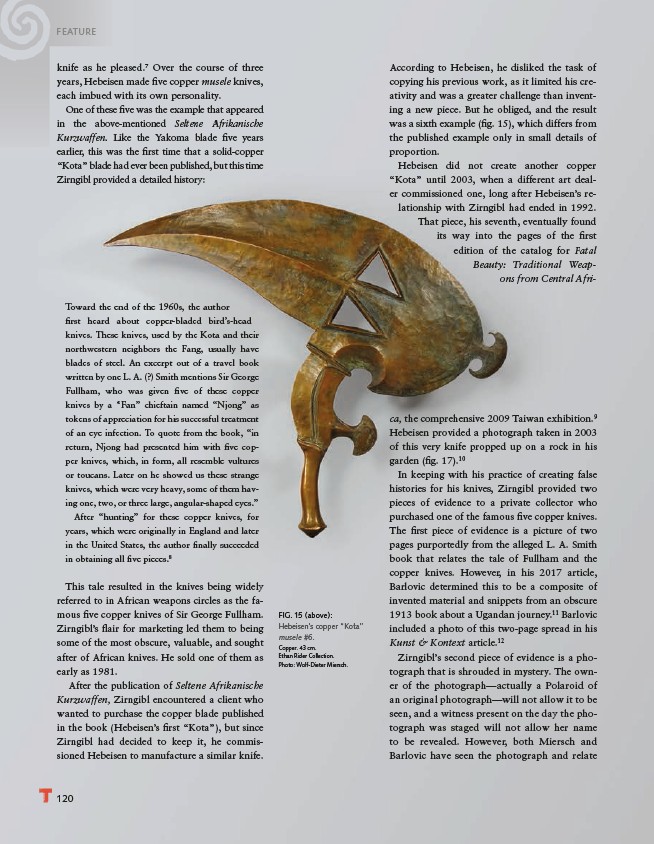
FEATURE
120
ca, the comprehensive 2009 Taiwan exhibition.9
Hebeisen provided a photograph taken in 2003
of this very knife propped up on a rock in his
garden (fi g. 17).10
In keeping with his practice of creating false
histories for his knives, Zirngibl provided two
pieces of evidence to a private collector who
purchased one of the famous fi ve copper knives.
The fi rst piece of evidence is a picture of two
pages purportedly from the alleged L. A. Smith
book that relates the tale of Fullham and the
copper knives. However, in his 2017 article,
Barlovic determined this to be a composite of
invented material and snippets from an obscure
1913 book about a Ugandan journey.11 Barlovic
included a photo of this two-page spread in his
Kunst & Kontext article.12
Zirngibl’s second piece of evidence is a photograph
that is shrouded in mystery. The owner
of the photograph—actually a Polaroid of
an original photograph—will not allow it to be
seen, and a witness present on the day the photograph
was staged will not allow her name
to be revealed. However, both Miersch and
Barlovic have seen the photograph and relate
Toward the end of the 1960s, the author
fi rst heard about copper-bladed bird’s-head
knives. These knives, used by the Kota and their
northwestern neighbors the Fang, usually have
blades of steel. An excerpt out of a travel book
written by one L. A. (?) Smith mentions Sir George
Fullham, who was given fi ve of these copper
knives by a “Fan” chieftain named “Njong” as
tokens of appreciation for his successful treatment
of an eye infection. To quote from the book, “in
return, Njong had presented him with fi ve copper
knives, which, in form, all resemble vultures
or toucans. Later on he showed us these strange
knives, which were very heavy, some of them having
one, two, or three large, angular-shaped eyes.”
After “hunting” for these copper knives, for
years, which were originally in England and later
in the United States, the author fi nally succeeded
in obtaining all fi ve pieces.8
This tale resulted in the knives being widely
referred to in African weapons circles as the famous
fi ve copper knives of Sir George Fullham.
Zirngibl’s fl air for marketing led them to being
some of the most obscure, valuable, and sought
after of African knives. He sold one of them as
early as 1981.
After the publication of Seltene Afrikanische
Kurzwaffen, Zirngibl encountered a client who
wanted to purchase the copper blade published
in the book (Hebeisen’s fi rst “Kota”), but since
Zirngibl had decided to keep it, he commissioned
Hebeisen to manufacture a similar knife.
FIG. 15 (above):
Hebeisen’s copper “Kota”
musele #6.
Copper. 43 cm.
Ethan Rider Collection.
Photo: Wolf-Dieter Miersch.
According to Hebeisen, he disliked the task of
copying his previous work, as it limited his creativity
and was a greater challenge than inventing
a new piece. But he obliged, and the result
was a sixth example (fi g. 15), which differs from
the published example only in small details of
proportion.
Hebeisen did not create another copper
“Kota” until 2003, when a different art dealer
commissioned one, long after Hebeisen’s relationship
with Zirngibl had ended in 1992.
That piece, his seventh, eventually found
its way into the pages of the fi rst
edition of the catalog for Fatal
Beauty: Traditional Weapons
from Central Afriknife
as he pleased.7 Over the course of three
years, Hebeisen made fi ve copper musele knives,
each imbued with its own personality.
One of these fi ve was the example that appeared
in the above-mentioned Seltene Afrikanische
Kurzwaffen. Like the Yakoma blade fi ve years
earlier, this was the fi rst time that a solid-copper
“Kota” blade had ever been published, but this time
Zirngibl provided a detailed history: